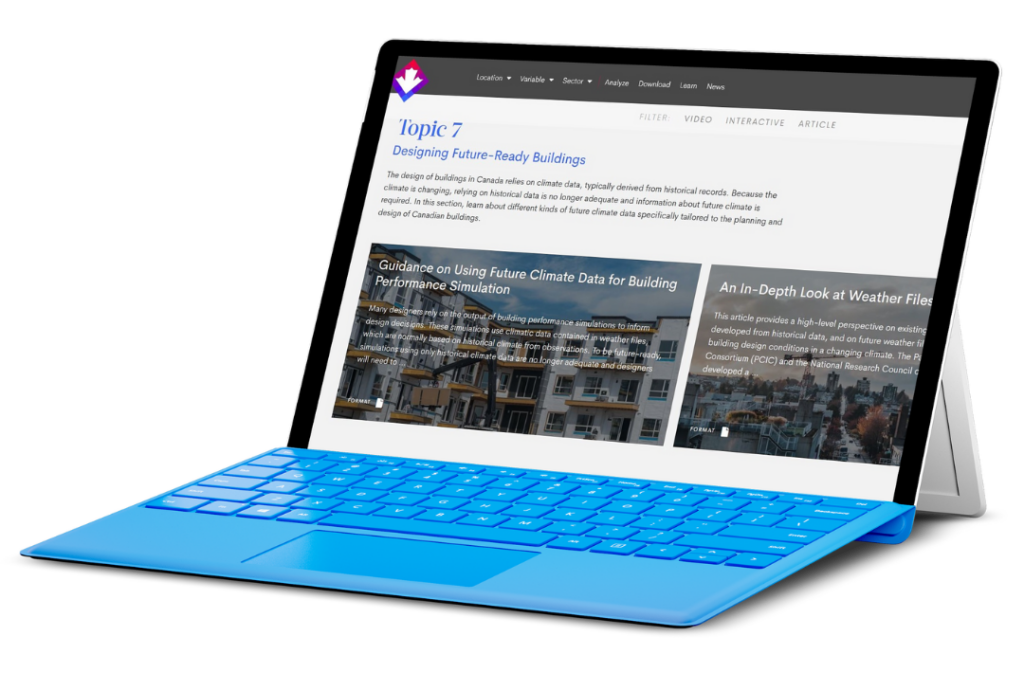Climate shapes building design
Climate has a major impact on a building’s design and energy performance. Designers and engineers use energy codes, such as the National Energy Code of Canada for Buildings (NECB), to ensure that a building can safely and comfortably withstand a wide range of weather conditions. The NECB has divided Canada into six “Climate Zones” to guide energy efficiency requirements – 4, 5, 6, 7a, 7b, and 8. Zone 4, for example, being the warmest, typically necessitates less insulation compared to Zone 8, the coldest. Each zone is based on the accumulation of Heating Degree Days (HDDs), a metric of winter heating demand. Importantly, these zones are usually computed from historical data, which means that they do not represent current and future climate conditions.
New: Future buildings climate zones
New projected Buildings Climate Zones data, computed from global climate model projections, offer a glimpse of the scale of climatic changes expected throughout this century and the impacts these changes will have on building energy demands. The new maps show clearly that Climate Zones in Canada will shift across all regions, changing heating and insulation needs.
While these zones give a high-level view of impending changes, like the decline in winter heating loads, it’s essential to note that they do not tell the full story. Extreme heat, changes in cooling needs, and emerging hazards are just some of the additional pieces of information designers and engineers consider to ensure buildings can withstand current, near-term, and long-term climatic changes under a range of possible climate change scenarios. Readers are therefore encouraged to consider future Climate Zones as a starting point on the path towards resiliency.
Beyond climate zones: Continuing on the road to resiliency
Buildings should be designed to function under the climatic conditions to which they are exposed throughout their full design lives, which is why integrating future climate data into our building designs is crucial. Two essential parts of this process are future weather files and future design values.
For a more thorough understanding, we invite you to explore our Learning Zone articles, Guidance on Using Future Climate Data for Building Performance Simulation and An In-Depth Look at Weather Files. These resources delve deeper into the types of future weather datasets that are available and how to use these datasets in building design applications in Canada.
Putting everything together: The Buildings sector module
Our vision is to enable meaningful adaptation within the buildings community. Our Buildings Sector Module provides easy access to building-relevant climate datasets, information, guidance, and case studies demonstrating the use of climate data in adaptation efforts. The Buildings Climate Zones, in addition to the new Learning Zone articles and technical datasets already on offer, is an important dataset in achieving our vision, but we are not done yet. Coming next, we will be posting new Learning Zone articles to the Designing Future-Ready Buildings topic, and we will be adding new for accessing additional types of technical data needed in building design, such as the future climatic design values by the Pacific Climate Impacts Consortium.
Building a climate resilient future together
As we transition to a future where climate resilience becomes a core element of building design, we are continuously expanding our learning resources to guide you on this journey. We invite you to stay connected with us by subscribing to our updates and joining us on social media to ensure you don’t miss our new offerings.
Together, let’s shape the future of Canadian infrastructure: resilient, adaptable, and ready for the challenges and opportunities that our changing climate brings.






